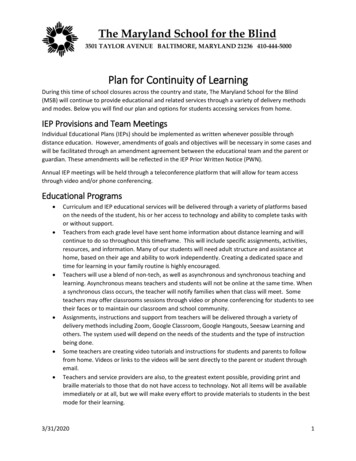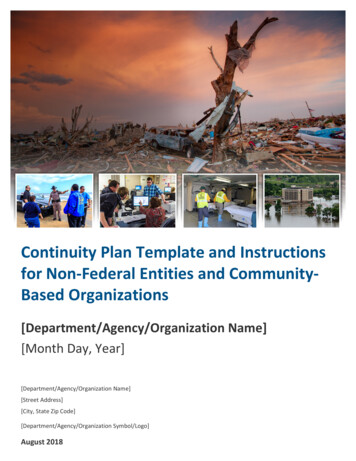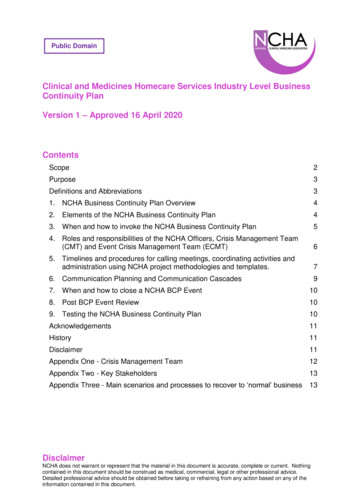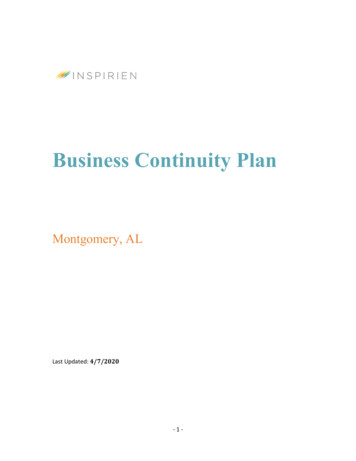
Transcription
Plan for Continuity of LearningDuring this time of school closures across the country and state, The Maryland School for the Blind(MSB) will continue to provide educational and related services through a variety of delivery methodsand modes. Below you will find our plan and options for students accessing services from home.IEP Provisions and Team MeetingsIndividual Educational Plans (IEPs) should be implemented as written whenever possible throughdistance education. However, amendments of goals and objectives will be necessary in some cases andwill be facilitated through an amendment agreement between the educational team and the parent orguardian. These amendments will be reflected in the IEP Prior Written Notice (PWN).Annual IEP meetings will be held through a teleconference platform that will allow for team accessthrough video and/or phone conferencing.Educational Programs Curriculum and IEP educational services will be delivered through a variety of platforms basedon the needs of the student, his or her access to technology and ability to complete tasks withor without support.Teachers from each grade level have sent home information about distance learning and willcontinue to do so throughout this timeframe. This will include specific assignments, activities,resources, and information. Many of our students will need adult structure and assistance athome, based on their age and ability to work independently. Creating a dedicated space andtime for learning in your family routine is highly encouraged.Teachers will use a blend of non-tech, as well as asynchronous and synchronous teaching andlearning. Asynchronous means teachers and students will not be online at the same time. Whena synchronous class occurs, the teacher will notify families when that class will meet. Someteachers may offer classrooms sessions through video or phone conferencing for students to seetheir faces or to maintain our classroom and school community.Assignments, instructions and support from teachers will be delivered through a variety ofdelivery methods including Zoom, Google Classroom, Google Hangouts, Seesaw Learning andothers. The system used will depend on the needs of the students and the type of instructionbeing done.Some teachers are creating video tutorials and instructions for students and parents to followfrom home. Videos or links to the videos will be sent directly to the parent or student throughemail.Teachers and service providers are also, to the greatest extent possible, providing print andbraille materials to those that do not have access to technology. Not all items will be availableimmediately or at all, but we will make every effort to provide materials to students in the bestmode for their learning.3/31/20201
For students whose classrooms use the Unique Learning System (ULS) teachers will be sendingwork packets either through the mail, in email or through the ULS online access system. This willbe based on the needs of the student and his or her access to technology in the home.Teachers will provide, at a minimum, educational activities in the following manner each week:elementary – one to two English/Language Arts or reading, one to two math and one content;elementary special areas – 1 lesson; secondary – one to two lessons per week per course. Thesewill be a combination of curriculum-based instruction and instruction to address IEP goals andobjectives.Related Services Tele-therapy will be provided through Google Meets, a HIPPA-secure platform that allows forvideo and/or audio interaction between therapist and student.Related service activities not requiring a HIPPA-secure platform may be provided in a variety offormats, based on the needs of the student, his or her access to technology and his/her ability tocomplete tasks with or without support.To the extent possible and to the extent necessary for the student to access his/her distanceeducation program, related service objectives will be implemented as stated in the IEPTo the extent possible and to the extent necessary for the student to access his/her distanceeducation program, related services will be implemented with the frequency and durationindicated in the IEP.In some cases, IEP services may be delivered to students indirectly, that is, the related serviceprovider may provide training to the parent versus working directly with the student.Changes to the IEP, including direct to indirect, adjustments to goals, objectives, frequencyand/or duration will be made through agreement with the parent and reflected in the IEP PriorWritten Notice (PWN).In situations where related services cannot be provided as indicated in the IEP, service providerswill provide the student/family with activities, tasks, and/or strategies that support thestudent’s continued development in indicated areas. In some situations, this may includeproviding instruction in other areas of the Expanded Core Curriculum (ECC) in an effort tocontinue providing the student with instruction and resources related to his/her independenceSupport to families may be in the form of phone contact, video demonstration/observation,print/braille packets, and/or email.Some related services will be integrated and presented within the context of the educationalprogram; e.g., seating strategies, use of adapted equipment, and communication systems maybe facilitated by the teacher in the context of the educational program rather than through anindependent session with a therapist. To the extent possible and to the extent it is useful for thestudent, equipment and devices necessary for students to access their educational program willbe sent home to students/families.Social Work and Psychology Support Support phone line (410.444.5000, ext 1249)3/31/20202
Messages left on this number will be returned by a social worker or psychologist within 24 to 48hours.Family and Community Support Facebook groupso Parent group – parent support groups, provision of resources, informal opportunities forparents to connecto Student group – In addition to the provision of a site for informal student connection,Recreation and Activity Specialists will lead weekly on-line social opportunities forstudentso Staff groupResidential-based Services Residential staff will work with the teacher/case manager to determine methods for providingsupport/ information to students/families. This includes, but is not limited to, the following:o Provision of task analyses, strategies for implementing residential objectives at homeo Contact with students/families at least once a week to answer questions/problem-solveissues related to implementing the students’ residential objectives at home.Weekly resources in the area of living skills will be offered to families through a variety offormats, e.g., email, print/braille packets, video demonstrations/observations, on-line resources.Given the nature of residential services, goals/objectives may need to be provided indirectlythrough training and consult with the parents/family.Change from direct to indirect service will be amended in the IEP as identified in the PWNOutreach ServicesNon-contractual ServicesOutreach staff continue to be available to offer consultative services to support local systems in IEPimplementation and parents. This can include: Individual consultation by videoconferencing or phone conferencing.Scheduled open Q&A sessions to support LSS with delivering distance learning to studentsScheduled open Q&A sessions for parents around promoting skills at homeTools and ResourcesGoogle ClassroomGoogle Classroom makes teaching more productive and meaningful by streamlining assignments,boosting collaboration, and fostering communication. Educators can create classes, distributeassignments, send feedback, and see everything in one place. Classroom also seamlessly integrates withother Google tools like Google Docs and Drive. You can also access this Quick start guide for tips to getyour classroom set.3/31/20203
Google MeetGoogle Meet is a video conferencing app. It is the business-oriented version of Google's Hangoutsplatform and is suitable for businesses of all sizes. The solution enables users to make video calls with upto 30 users per high-definition video meeting. To get started, go to the Google Meet support page.Google HangoutsUse Hangouts to keep in touch. Message friends start free video or voice calls, and hop on aconversation with one person or a group. Include all your friends with group chats for up to 150 people.Say more with photos, videos, maps, emoji, stickers, and animated GIFs. Turn any conversationinto a free group video call with up to 10 friends.Keep in touch with friends across Android, iOS, and the web, and sync chats across all yourdevices.Message friends anytime, even if they’re offline.Snooze your notifications so you can respond later.See what you chatted about in the past, including shared photos and your video call history.Keep a record of any conversation for just a short period of time by turning history off.Connect your Google Voice account to make calls, send and receiveGoogle VoiceWith Google Voice, you get a free phone number for calls, text messages, and voicemail. You can use theapps on smartphones and computers, and you can link your number to any mobile or landline number.Office 365Students and educators at eligible institutions can sign up for Office 365 Education for free, includingWord, Excel, PowerPoint, OneNote, and now Microsoft Teams, plus additional classroom tools. All youneed is a valid school email address. It’s not a trial – so get started today.ZoomVideo and phone conferencing with free or paid account options. Currently, Zoom is waiving the 40minute time limit on free account meetings.FreeConferenceCall.comFree teleconferencing, video conferencing, and screen sharing with recording capability.WebexVideo and phone conferencing with free or paid account options.SkypeVideo and phone conferencing with free or paid account options.3/31/20204
RemindTexting and two-way messaging app for phone and PC. Allows communication with parents andstudents without sharing personal phone number. Remind will also translate messages into a variety oflanguages.Free wifiAs the country deals with the effects of the Coronavirus (COVID-19), Comcast is taking immediate stepsto help connect more low-income families to the Internet at home. Effective Monday, March 16, 2020,new Internet Essentials customers will receive two free months of Internet service. We are alsoincreasing the speed of the program to 25 Mbps downloads, and 3 Mbps uploads for all new andexisting customers.After your first two free months expire, you can either cancel the service (which you can do at any time)or keep it as a regular paying Internet Essentials customer. You will receive an easy to use self-install-kitthat includes a cable modem (to receive service at your home) with a WiFi router (to connect yourdevices without wires). There is no term contract or credit check and no shipping fee for equipment.SeesawStudent-driven digital portfolios and remote learning. Early Learning program will be using Seesaw forinstruction.ClassDojoClassDojo helps you instantly communicate and engage with all families and students, so you can keepbuilding those relationships while school is closed.EdmodoDistance Learning ToolkitAs the COVID-19 virus continues to spread and impact school communities, we want to do what we canto help. Teachers, students, and parents can use Edmodo to communicate and continue education—always for free—even when in-person learning isn’t possible.FlipgridOnline meeting space for teachers and students to create video and text that can be shared with classes,schools or communities.NewselaNewsela is offering free access to all content during school closures.Newsela is a data base of current events stories tailor-made for classroom use. Indexed by broad theme(e.g. War and Peace, Arts, Science, Health, Law, Money), stories are both student-friendly and can beaccessed in different formats by reading level. Use Newsela to differentiate nonfiction reading.Newspaper writers rewrite a story four times for a total of five Lexile levels per story. All articles haveembedded, Common Core aligned quizzes that conform to the reading levels for checkingcomprehension. An account is required to use Newsela, both for teachers and for students, but students3/31/20205
sign up using a teacher or parent provided code rather than an email address. Teachers can createclasses and assign reading-level specific articles to individual students or download printable PDF copiesof the article in any of its reading-level versions. There is an upgraded fee-based Pro Version whichallows teachers or administrators to track reading progress and students to take constructed responsewriting assessments, but many of the features are free and there is no outside advertising.Khan AcademyKhan Academy offers practice exercises, instructional videos, and a personalized learning dashboardthat empower learners to study at their own pace in and outside of the classroom. We tackle math,science, computer programming, history, art history, economics, and more. Our math missions guidelearners from kindergarten to calculus using state-of-the-art, adaptive technology that identifiesstrengths and learning gaps. We've also partnered with institutions like NASA, The Museum of ModernArt, The California Academy of Sciences, and MIT to offer specialized content.ObjectiveEdWe are providing free access to our digital curriculum to schools and teachers to use with their studentswith vision impairments through the end of the current 2019/2020 school year.ObjectiveEd’s distance learning help students practice many of the Expanded Core Curriculum, withskill-building games for Orientation and Mobility, Assistive Technology and Braille Literacy.For example, students can improve their early braille literacy skills using ObjectiveEd’s Braille Sheets,where you place a sheet of braille on an iPad, and the iPad knows what’s on that sheet, and studentsplay a game that improves their braille skills. ObjectiveEd won the Louis Braille Touch of Geniusaward for Braille Sheets, as well as awards from the American Council of the Blind.For advanced braille literacy skills, ObjectiveEd provides Braille AI Tutor, funded by a Microsoft AI forAccessibility grant. As a child reads from their refreshable braille display, they speak as theyread. Using speech recognition, Braille AI Tutor listens to their speech, converts it into text, andcompares that text to the original sentence sent to the braille display. If they are the same, the child hasdecoded and read the sentence correctly. This enables a child to practice their braille literacy remotely,between sessions with their itinerant teacher.ObjectiveEd’s Orientation and Mobility games include building directionality skills, wayfinding skills,audio location and timing skills, sequencing, categorization, identification and memory.Lakeshore LearningFree resources from Lakeshore Learning.ReadTheoryImprove your students’ Reading Comprehension. It’s free.Personalized reading comprehension exercises forK-12 and ESL students.3/31/20206
Paths to LiteracyCoping with school closures due to COVID-19. Lots of resources for online instruction and activities forstudents at home.This is a frightening time for people throughout the world as the COVID-19 turns our routine lives insideout. There is uncertainty for ourselves and our loved ones, and we are caught without having had timeto get services in place for children with visual impairments. Fortunately, teachers, Orientation andMobility specialists, parents, and others are rising to the occasion to share ideas and resources to helpus all get through this!National Homework Hotline for Blind/Visually Impaired StudentsHomework telephone hotline for blind/vision impaired students in grades K-12 experiencing emergencyschool closures due to COVID-19.VI Distance Learning IdeasA list of distance learning ideas compiled by a Teacher of Students with Visual Impairments.Hadley Institute Discussion GroupsA variety of regular discussion groups that can be accessed free of charge by phone or computerVirtual Book Club for KidsWeekly theme, with a featured book that you and your toddler/preschooler/kindergarten can share plus5 simple activities that are easy to do at home.Free Family Dinner Book ClubShare a great story, great art, great conversation and great food each month. A variety of picture booksand chapter books chosen for your enjoyment. The project is perfect for children ages 4-8, but can easilybe adapted for younger and older children.PBLWorksOnline resource for Project-based LearningCorbett HarrisonFree writing lessons and resources for writing teachersScholasticFree remote teaching resources for K-12PBSKidsEducational games and videos from PBS Kids.Virtual Expanded Core Education Learning (ExCEL) Academy for Students with VisualImpairmentsIn this time of need, if you are looking for ways to provide virtual services or activities for your studentor child who is visually impaired, please join us for the launch of free nationwide programming. We hope3/31/20207
to offer engaging lessons for students with a variety of abilities. We also hope to model ways that onlinelearning could be used for services. We understand that children’s needs are unique and that lessonsmay not apply for all kids, but we are dedicated to working out a plan to provide as much as we can. Aschedule will be coming out shortly with a list of instructors’ names and topics.Teaching Students with Visual Impairments Guide to Online InstructionWe are in an unprecedented time in our lives where many schools are closing or moving to onlineinstruction. To support you as you transition into this new means of providing instruction, I have puttogether this page to provide you with strategies and resources. As I discover resources and developactivities, I will continue to share them with you.Teaching Special Education Online During COVID-19Webinar presented by CEC and associated tools and resources. The linked PDF gives an extensive list oftools and options for student, parent and teacher engagement.Parent-Created Schedule for Home-Based School ActivitiesFrom Paths to LiteracyScholastic Learn At HomeEven when schools are closed, you can keep the learning going with these special cross-curricularjourneys. Every day includes four separate learning experiences, each built around a thrilling,meaningful story or video. Kids can do them on their own, with their families, or with their teachers. Justfind your grade level and let the learning begin!Story and Song Videos for Students with CVIShort story and song videos with visual modifications for students with CVI.Dynamic Learning Maps At-Home Learning ResourcesWith an increased demand for resources to use in at-home learning settings, the Dynamic LearningMaps (DLM) Consortium offers the following list of resources and ideas on using them. Thesesuggestions are offered in appreciation for the work that our teachers do every day to assure that theirstudents with significant cognitive disabilities are engaged, focused, and learning.Tar Heel ReaderTar Heel Reader is an online collection of free, easy-to-read, and accessible books on a range of topics.Each book can be read using built-in speech synthesis and accessed using multiple interfaces includingtouch screens, switches (1-3), and eye-gaze. Read books without registering. To write books, request anaccess code at tarheelreader@cs.unc.edu.Tar Heel Shared ReaderTar Heel Shared Reader uses books from the Tar Heel Reader library and includes on-screencommunication supports. Read books without registering. To add comments to books, request an access3/31/20208
code at tarheelreader@cs.unc.edu. To learn more about using Tar Heel Shared Reader during sharedreading, check out http://sharedreader.org.Shared Reading VignettesGrade 3 Shared Reading Vignette My Father’s Dragon Unit – “Wild Island”Grade 4 Shared Reading Vignette The Birchbark House Unit – “Omakayas”Grade 5 Shared Reading Vignette The Secret Garden – “Families”Grade 7 Shared Reading Vignette Hatchett – “Moose”Grade 9-10 Shared Reading Vignette The White Heron – “Making a Dress”Grade 11-12 Shared Reading Vignette To Kill a Mockingbird – “Dad Loved the Farm”These vignettes describe what a shared reading interaction might look like between an adult and astudent with significant cognitive disabilities. These vignettes are especially helpful to those trying toengage in shared reading with children/students who have limited means of communication.DLM Familiar TextsDLM alternate assessments use specific "familiar texts.” These books include fictional stories andinformational text. The books are organized by grade level. They can be read in Tar Heel Reader or TarHeel Shared Reader if a student needs communication support.Science Instructional ActivitiesThese science activities support teachers who are using DLM science Essential Elements duringinstruction. Model activities for each grade band (elementary, middle, and high school) are included andcan be adapted for use at home.Storyline OnlineStoryline Online streams videos featuring famous actors reading children’s books. Children can see thebook pages and read along with these award-winning books. Children of all ages and their parents willfind new books to love and old favorites on this site.Precursor Essential Element DescriptionsThis document lists Essential Elements with descriptions of the connection between Initial and DistalPrecursors for both mathematics and ELA; includes links to helpful instructional suggestions and toolsincluding the familiar texts listed above.Project Core3/31/20209
This site provides communication supports for students as well as training and resources for adults.Project Core features a set of 36 core vocabulary words that reflect the DLM First 40, which arehighlighted throughout the DLM system. This resource will be especially helpful to families and teamssupporting students who are home without a means of communication and interaction.Writing SupportsCheck out these resources to support writing with an alternate pencil. Then, support the student indeciding what or whom to write about before selecting letters that you record. You can learn moreabout supporting writing in the learning modules at http://dlmpd.com.Teacher Learning Modules for ELA, Mathematics, and ScienceThese modules are available in online, on-demand formats to help adults understand how to teach ELA,mathematics, and science to students with significant cognitive disabilities. They were designedprimarily for teachers, but have been used with great success by parents.Contact InformationYour primary point of contact continues to be your child’s teacher, but you may feel free to reach out tothose listed below as well.Director of EducationJoshua Irzyk, joshuai@mdschblind.orgDirector of Residential and Related ServicesMaureen Bisesi, maureenb@mdschblind.orgEarly Learning Coordinator/PrincipalKaren Frank, karenf@mdschblind.orgPrincipal, Autism Blind and Functional Academic ProgramsCarol Seckington, carols@mdschblind.orgPrincipal, General Academic ProgramNicholas Pagani, nicholasp@mdschblind.orgPrincipal, Multiple Disabilities ProgramPhyllis Simmons, phyllis@mdschblind.orgDirector of Statewide Outreach ServicesRuth Ann Hynson, ruthh@mdschblind.org3/31/202010
Google Meet is a video conferencing app. It is the business-oriented version of Google's Hangouts platform and is suitable for businesses of all sizes. The solution enables users to make video calls with up to 30 users per high-definition video meeting. To get started, go to the Google Meet support page. Google Hangouts Use Hangouts to keep in .











